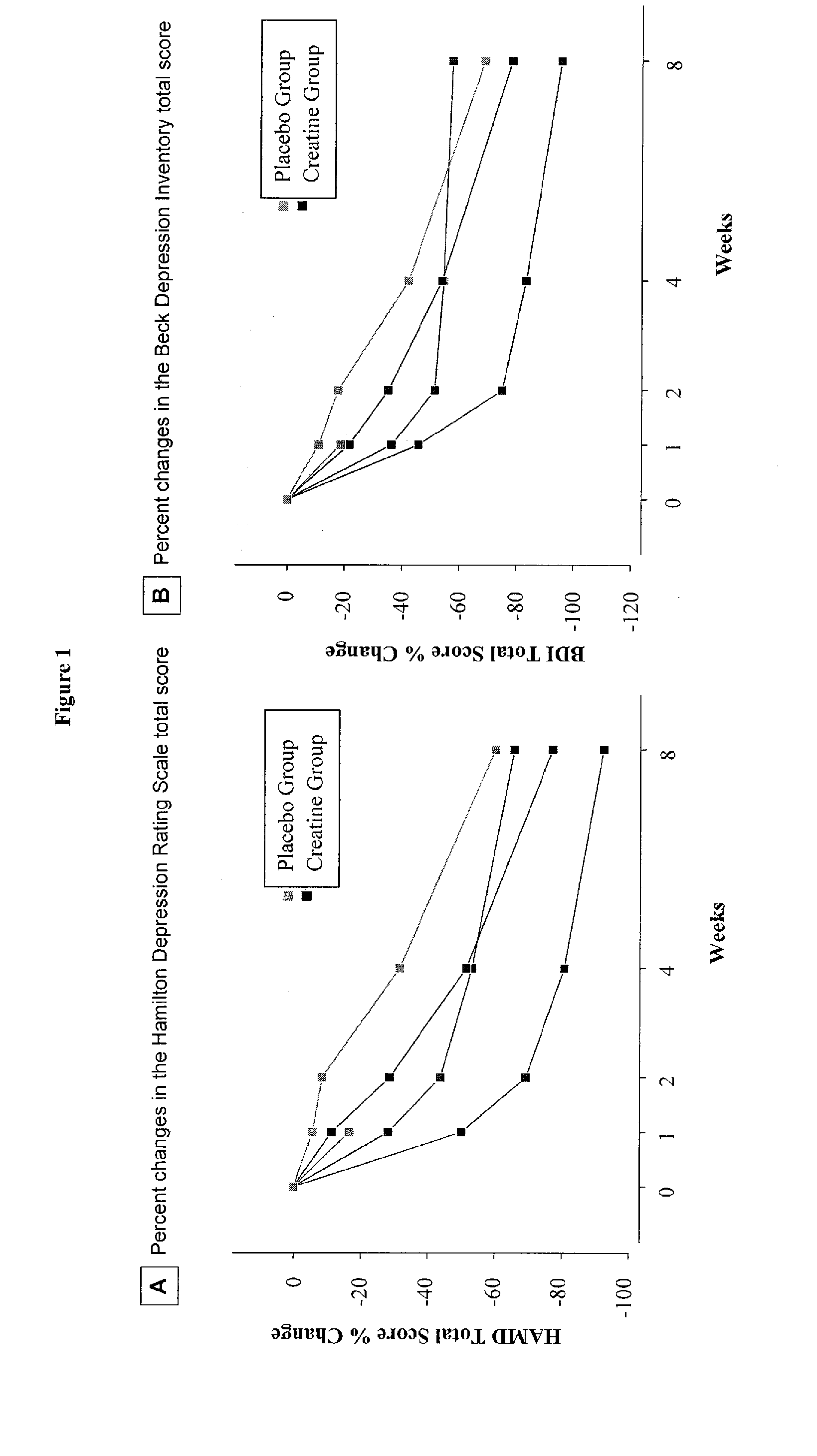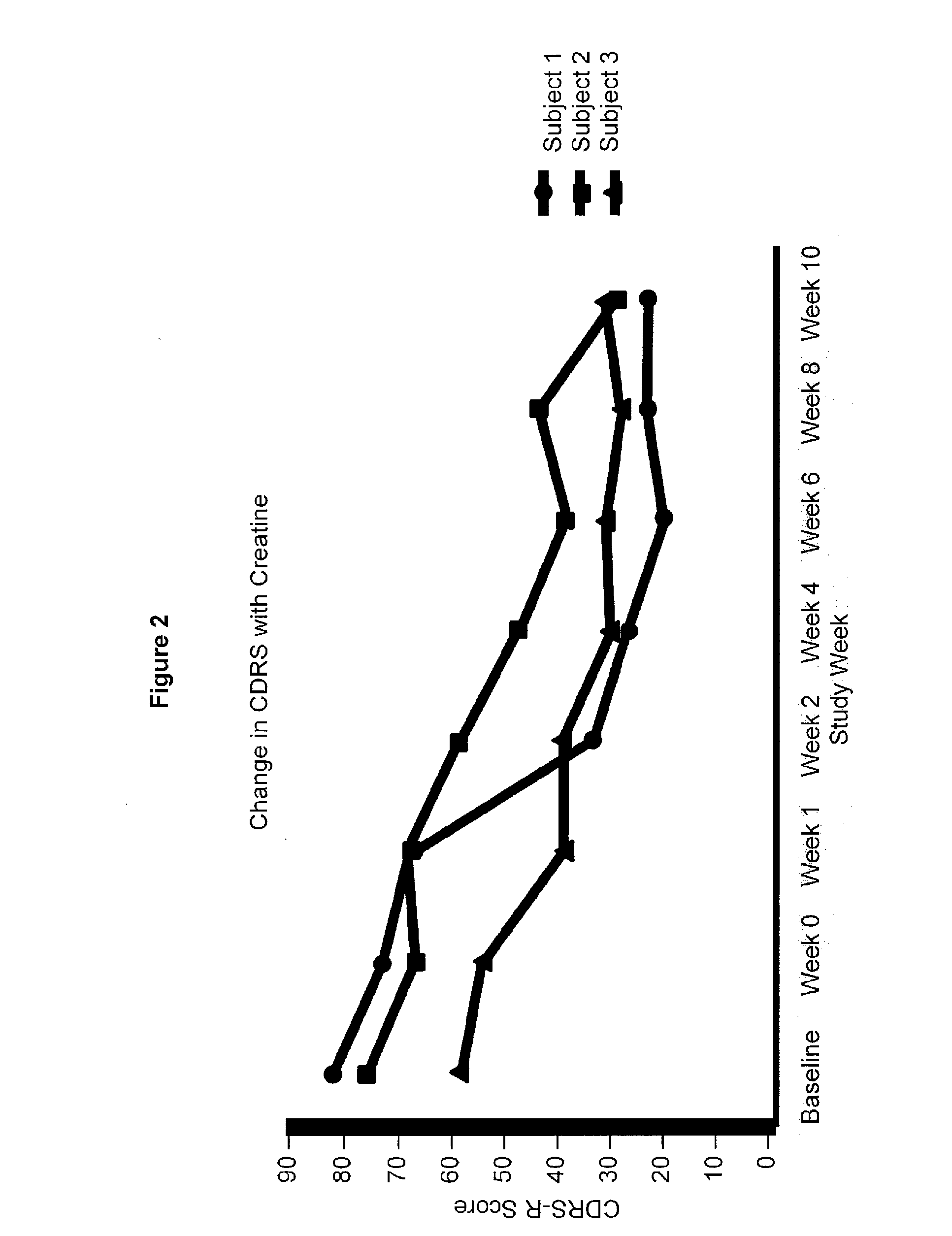Methods for the treatment of psychiatric disorders
a psychiatric disorder and treatment method technology, applied in the field of psychiatric disorders, can solve the problems of few proven treatment options for mdd patients, poorly understood neuronal mechanisms underlying mdd, and inability to identify the mechanism and biological correlates of treatment resistance in mdd patients, etc., to achieve less toxic, convenient treatment, and great
- Summary
- Abstract
- Description
- Claims
- Application Information
AI Technical Summary
Benefits of technology
Problems solved by technology
Method used
Image
Examples
example 1
Clinical Study of the Effect of a Creatine-Containing Compound on Male MDD Subjects
[0068]A clinical study was performed to study the effect of creatine administration on male MDD subjects. A total of 6 male subjects (mean age of 42.7 years; age range 27 to 63) were enrolled in this study. Among the subjects, 5 subjects (mean age of 38.6 years; age range of 27 to 59) underwent at least one follow-up assessment. Three subjects received 5 g / day creatine monohydrate (as a powder), and two subjects received a placebo. The MDD symptoms of the subjects were assessed using the Hamilton Depression Rating Scale (HAMD) (FIG. 1A) or the Beck Depression Inventory (BDI) (FIG. 1B). The baseline HAMD total score for intention-to-treat sample was 30.4 (standard deviation of 5.1) and the baseline BDI total score was 31 (standard deviation of 11.3). The clinical data in FIGS. 1A and 1B indicate that creatine reduces the symptoms of MDD in male subjects.
example 2
Clinical Study of the Effect of a Creatine-Containing Compound on MDD Subjects Living at High Altitudes
[0069]A clinical study was performed to determine the effect of creatine on adolescent MDD patients living at high altitude (Salt Lake City; elevation of 4,300 feet). In this study, three adolescents diagnosed as having MDD and living at high altitude were administered 5 g / day of creatine monohydrate (as a powder). The subjects in the study were monitored using the Children's Depression Rating Scale (CDRS). The study was performed for 1 to 10 weeks. Adolescents receiving creatine demonstrated a reduction in CDRS score (FIG. 2). These clinical data indicate that creatine reduces the symptoms of MDD in patients living at high altitude.
example 3
Additional Methods for the Assessment of a Creatine-Containing Compound on Male MDD Subjects and MDD Subjects Living at High Altitude
[0070]The effect of a creatine-containing compound on male MDD subjects and on MDD subjects living at high altitude may also be assessed using phosphorus magnetic resonance spectroscopy (31P-MRS). Subjects having MDD have consistently shown lower levels of beta-nucleoside triphosphate (beta-NTP; primarily adenosine triphosphate in brain) and total NTP, with normal or slightly elevated high energy phosphate phosphocreatine (PCr) in the basal ganglia and frontal brain regions of MDD subjects. These findings in MDD subjects may reflect the altered turnover of ATP to PCr. Male MDD subjects and MDD subjects living at high altitudes receiving a creatine-containing compound may show improvements in these energetic abnormalities (e.g., increased PCr and reduced beta-NTP levels at baseline or an increased PCr / beta-NTP ratio).
[0071]The effect of a creatine-conta...
PUM
| Property | Measurement | Unit |
|---|---|---|
| elevation | aaaaa | aaaaa |
| elevation | aaaaa | aaaaa |
| elevation | aaaaa | aaaaa |
Abstract
Description
Claims
Application Information
 Login to View More
Login to View More - R&D
- Intellectual Property
- Life Sciences
- Materials
- Tech Scout
- Unparalleled Data Quality
- Higher Quality Content
- 60% Fewer Hallucinations
Browse by: Latest US Patents, China's latest patents, Technical Efficacy Thesaurus, Application Domain, Technology Topic, Popular Technical Reports.
© 2025 PatSnap. All rights reserved.Legal|Privacy policy|Modern Slavery Act Transparency Statement|Sitemap|About US| Contact US: help@patsnap.com


